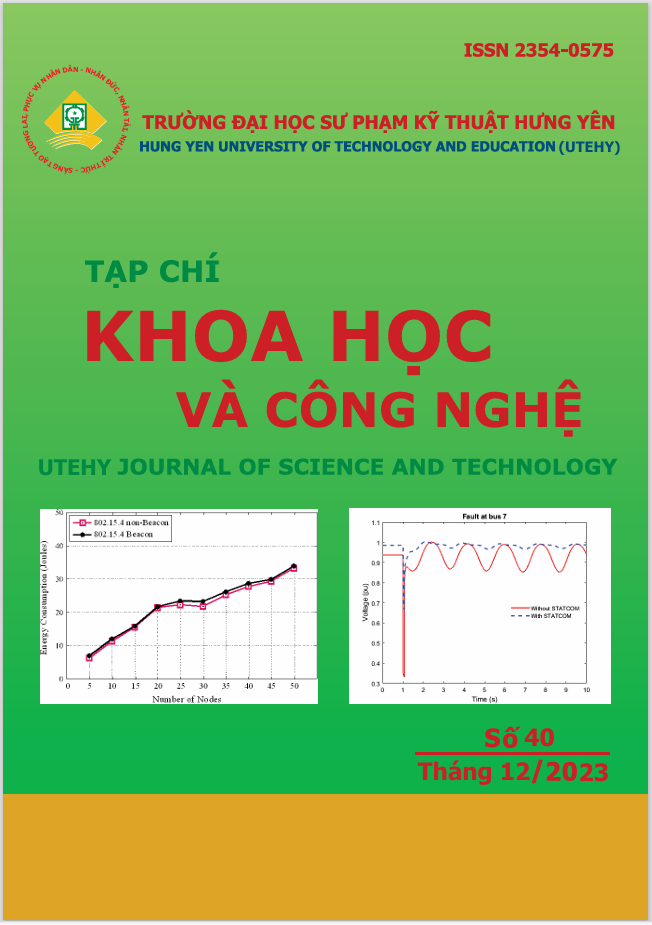RESEARCH ON THE STRUCTURE, ELECTRICAL AND OPTICAL PROPERTIES OF TRANSPARENT CONDUCTIVE OXIDE THIN FILM SNO 2 DOPED WITH CERIUM FLUORIDE FOR APPLICATION IN OPTOELECTRONIC DEVICES
Abstract
This paper presents a study on the structural, electrical, and optical characteristics of tin oxide (SnO2) thin films doped with 2 mol.% cerium trifluoride (CeF3). Employing the sol-gel dip coating technique, these films were deposited onto glass substrates and subsequently annealed in air at temperature of 450 °C. The structural analysis revealed that CeF3 doping significantly alters the crystallinity and grain size of SnO2 film. Electrical measurements indicated a transition from n-type conductivity in the undoped SnO2 film to p-type in the film doped with CeF3. This change was validated through measurements of both Hall effect and Seebeck coefficient. The doped film exhibited a decreased electrical resistivity and increased carrier concentration, with values of 1.72 × 10–2 Ωcm and +5.35 × 1019 cm–3, respectively. Optical assessments demonstrated that the CeF 3 doped SnO2 (CFTO) film has high level of transparency across the visible spectrum, measuring 80 % at 550 nm. Our findings suggest that the incorporation of CeF3 into SnO2 film is a promising approach to developing transparent conductive oxides (TCOs) for specific optoelectronic applications. The enhanced p-type conductivity, coupled with high optical transparency and low electrical resistivity, positions this film as potential candidates for next-generation optoelectronic devices, especially when coupled with homo- or hetero-junctions, which can further enhance their performance and versatility in various optoelectronic devices.
References
K. J. S. Sujatha Lekshmy, “SnO2 thin films doped indium prepared by the sol–gel method: structure, electrical and photoluminescence properties,” Journal of Sol-Gel Science and Technology, 2013, vol. 67, no. 1, pp. 29-38.
H. Y. H. Kawazoe, K. Ueda, H. Hosono, “Transparent p-type conducting oxides: design and fabrication of p-n heterojunctions,” MRS Bulletin, 2000, 25, pp. 28-36.
C. Wu et al., “High sensitive and stable self-powered solar-blind photodetector based on solutionprocessed all inorganic CuMO2/Ga2O3 pn heterojunction,” Materials Today Physics, 2021, vol. 17.
N. Zhang et al., “High performance p-type transparent LaCuOS thin film fabricated through a hydrogen-free method,” Applied Materials Today, 2018., vol. 13, pp. 15-23
M. F. Al-Kuhaili and M. B. Mekki, “P-type conductivity in hydrogenated radio frequency sputtered tin oxide thin films,” Journal of Alloys and Compounds, 2019, vol. 772, pp. 801-807.
T. Le, H. P. Dang, Q. H. Luc, and V. H. Le, “A study of structural, electrical, and optical properties of p-type Zn-doped SnO2 films versus deposition and annealing temperature,” Journal of Physics D: Applied Physics, 2017, vol. 50, no. 14.
K. Ravichandran, K. Thirumurugan, N. Jabena Begum, and S. Snega, “Investigation of p-type SnO2:Zn films deposited using a simplified spray pyrolysis technique,” Superlattices and Microstructures, 2013, vol. 60, pp. 327-335.
H. P. Dang, Q. H. Luc, V. H. Le, and T. Le, “The influence of deposition temperature and annealing temperature on Ga-doped SnO2 films prepared by direct current magnetron sputtering,” Journal of Alloys and Compounds, 2016, vol. 687, pp. 1012-1020.
Y. Huang, Z. Ji, and C. Chen, “Preparation and characterization of p-type transparent conducting tin-gallium oxide films,” Applied Surface Science, 2007, vol. 253, no. 11, pp. 4819-4822.
A. Z. Md. Tareq Rahman, Ahmed Y, Rahman MS, Toma FTZ, “Investigating the Effect of Annealing Temperatures on SnO2 Nano Structural Thin Films and their Properties,” Journal of Nanoscience, Nanoengineering & Applications, 2022, vol. 12, no. 1, pp. 28-39.
I. Y. Y. Bu, “Sol–gel deposition of fluorine-doped tin oxide glasses for dye sensitized solar cells,” Ceramics International, 2014, vol. 40, no. 1, pp. 417-422.
N. Zhang, X. Liu, D. Shi, B. Tang, A. Annadi, and H. Gong, “Achievement of highly conductive p-type transparent NdCuOS film with Cu deficiency and effective doping,” Materials Today Chemistry, 2018, vol. 10, pp. 79-89.
D. Xiong et al., “Preparation of p-type AgCrO2 nanocrystals through low-temperature hydrothermal method and the potential application in p-type dye-sensitized solar cell,” Journal of Alloys and Compounds, 2015, vol. 642, pp. 104-110.
C. E. Benouis et al., “The low resistive and transparent Al-doped SnO2 films: p-type conductivity, nanostructures and photoluminescence,” Journal of Alloys and Compounds, 2014, vol. 603, pp. 213-223.
K. Ueda, S. Inoue, S. Hirose, H. Kawazoe, and H. Hosono, “Transparent p-type semiconductor: LaCuOS layered oxysulfide,” Applied Physics Letters, 2000, vol. 77, no. 17, pp. 2701-2703.
P. A. Sivakumar, Harish Sharma Ranjeth Kumar Reddy, T.Srinivas Reddy, G.Kambhala, Nagaiah Nanda Kumar Reddy, N., “Influence of Ga doping on structural, optical and electrical properties of transparent conducting SnO2 thin films,” Optik, 2021, vol. 226.
Q.-P. Tran, J.-S. Fang, and T.-S. Chin, “Properties of fluorine-doped SnO2 thin films by a green sol–gel method,” Materials Science in Semiconductor Processing, 2015, vol. 40, pp. 664-669.
F. Arefi-Khonsari, N. Bauduin, F. Donsanti, and J. Amouroux, “Deposition of transparent conductive tin oxide thin films doped with fluorine by PACVD,” Thin Solid Films, 2003, vol. 427, no. 1-2, pp. 208-214.
C. S. S. Shanthi, P. Ramasam, “,” Journal of Crystal Growth, 1999, 197, pp. 858–864.
B. Saha, S. Das, and K. K. Chattopadhyay, “Electrical and optical properties of Al doped cadmium oxide thin films deposited by radio frequency magnetron sputtering,” Solar Energy Materials and Solar Cells, 2007, vol. 91, no. 18, pp. 1692-1697.
P. Sakthivel, S. Asaithambi, M. Karuppaiah, S. Sheikfareed, R. Yuvakkumar, and G. Ravi, “Different rare earth (Sm, La, Nd) doped magnetron sputtered CdO thin films for optoelectronic applications,” Journal of Materials Science: Materials in Electronics, 2019, vol. 30, no. 10, pp. 9999-10012.
Q.-P. Tran, J.-S. Fang, A.-Y. Lo, and T.-S. Chin, “p-Type highly conductive and transparent NdF3-doped tin oxide films prepared by dip coating,” Thin Solid Films, 2016, vol. 618, pp. 159-164.

